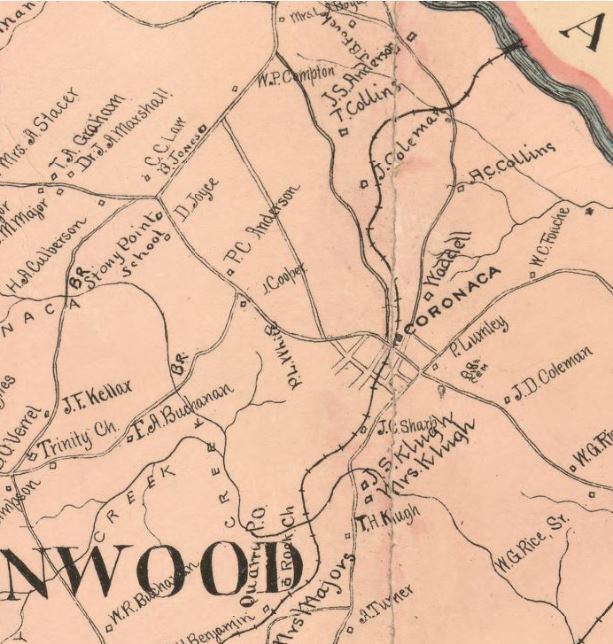“Early investments in textiles, pays off handsomely…”
City Directories and History: Stony Point is built in a style commonly found in the Central Atlantic States, and was reminiscent of the family’s Virginia roots. The classically inspired house of Flemish bond brick is five bays wide and is capped by a jerkinhead roof with corbeling at the roofline. There are twin exterior end chimneys with corbeled caps on both sides of the house. The surroundings include three

Bullock, W. P, and Paul L Grier. Official topographical map of Abbeville Co., South Carolina. [S.l.: P.L. Grier, 1894, 1895] Map. Retrieved from the Library of Congress
(Courtesy of South Carolina Department of Archives and History)
Further information: Three generations of owners of the two story brick house — William Smith, Joel Smith, and Wyatt Aiken — were wealthy, prominent men, who worked for community and state improvements. In 1808, William Smith established the second post office in Greenwood County. His son, Joel Smith was one of the largest stockholders in the Graniteville Manufacturing Company, William Gregg’s model factory to promote industry in the South. Smith’s son-in-law, D. Wyatt Aiken, founded the South Carolina Grange, a farmers’ organization, and edited the Rural Carolinian, post War-Between-the-States efforts to improve and diversify farming methods. The Flemish-bond brick house, elegant and imposing for

Picking cotton fields by hand, throughout the South, was a common event in the fall, prior to ca. 1950s. Postcard view in Newberry Co., (it could easily have been photographed across nearly any county in the Carolinas), courtesy of the Davie Beard Collection – 2017
upcountry South Carolina, reflects the prestige and influence of the 19th Century owners of Stony Point and the Virginian origin of the first owner. Construction of Stony Point was begun under the ownership of William Smith. A native of Culpepper County, Virginia, Smith moved to the Greenwood area in 1793. The father of thirteen children, he operated a store and in 1808 established a post office, the second in Greenwood County, at Stony Point. In 1818 William Smith began construction of a new home. He died six years later and the brick house was bought from the estate and completed by his son, Joel Smith. Joel Smith (1798-1855), one of the wealthiest men of his era in South Carolina outside Charleston, wielded great influence in the Upcountry in his various roles as a planter, merchant, banker, and supporter of industries and railroads. Smith owned 1,883 acres of land and 78 slaves. In addition to farming, he continued the store established by his father at Stony Point and also served as postmaster from 1824 to 1844 and from 1851 to 1853. He served in the South Carolina House of Representatives from 1840-1848.
Smith was a far-sighted entrepreneur. At a time when corporations were unpopular in South Carolina, being associated in the public mind with speculations, he was one of the four incorporaters of Graniteville Manufacturing Company and held stock in the enterprise valued at $25,000. In the Graniteville undertaking, Smith followed the lead of William Gregg who promoted manufacturing in the South, deploring the largely agrarian economy based on slave labor. Gregg, Smith, and other stockholders were innovative not only in their plans for factories using poor white labor in the South, but also in their method of supporting the factory through corporate capital enterprise. (Courtesy of the NR Nomination Information)
A stop on the Built of Brick Jaunt – Driving Tour
R&R NOTE: In route to the village of Cokesbury, S.C., CSA President Jefferson Davis, passed Stony Point plantation home after crossing the Saluda River at Puckett’s Ferry on May 1, 1865, and worked his way through Coronaca, S.C. to Cokesbury. Coronaca was revived as a place name in 1858 by D. Wyatt Aiken for his place south of Stony Point. The Confederate War brought a halt to construction of his home, and it was never finished. About 1884 when the railroad was extended from Greenwood to Laurens, a stop between Greenwood and Saluda River was named Coronaca, probably by Aiken or some member of his family. The town grew up around the railroad depot. (Information from: Greenwood County Sketches by Margaret Watson, 1982, p. 124)
Stay Connected
Explore history, houses, and stories across S.C. Your membership provides you with updates on regional topics, information on historic research, preservation, and monthly feature articles. But remember R&R wants to hear from you and assist in preserving your own family genealogy and memorabilia.
Visit the Southern Queries – Forum to receive assistance in answering questions, discuss genealogy, and enjoy exploring preservation topics with other members. Also listed are several history and genealogical researchers for hire.
User comments welcome — post at the bottom of this page.
Please enjoy this structure and all those listed in Roots and Recall. But remember each is private property. So view them from a distance or from a public area such as the sidewalk or public road.
Do you have information to share and preserve? Family, school, church, or other older photos and stories are welcome. Send them digitally through the “Share Your Story” link, so they too might be posted on Roots and Recall.
Thanks!



